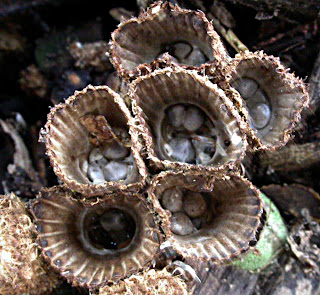Reasonable weekend at Tophill Low, East Yorks, made better by making the correct guess that Saturday evening's Semi-palmated Sandpiper at Spurn wouldn't be there on Sunday! I'm sure a huge disappointment for those that decided to go and see where it once was!
But a good weekend on the local patch... finally caught up with one of the autumn Ospreys, and the raptor supplement included a sub-adult male Marsh Harrier thru and a new Peregrine in the area, an adult male. The Black-necked Grebe remains on D res, while the trickle of wader passage included 2 Ringed Plover, 2+ Common Sands, several Ruff and the 3 Curlew Sandpipers that still linger. Saturday was pretty dreadful for any gulls being around, but Sunday saw a little movement of Lesser Black-backs thru with 26 'in and out' south, and a 2nd winter Mediterranean Gull appeared briefly early evening before disappearing south.
The weekly new species was added to the Tophill site list. This week Doug Fairweather decided Fluted Birds-nest was the species... taking the fungi site list to 272 with a couple more pending identification. I'm sure our great tutor, Keith Allison, would have been proud we've continued to push the list along at a good pace.
Lots of fungi on the go at the moment. Copper Spike, Grey Knight, Shaggy Inkcap, Coltsfoot rust, Sulphur Tuft, Blue Roundhead, Dog Stinkhorn and Pestle Puffball (the latter two pictured below)
Despite the warmth of Friday night, the moth trapping was at best sundry species only. Albeit we did add Small Wainscot, Brown-spot Pinion and Angle Shades to the year list, the latter species one that has declined in the traps in recent years. The rest of it was made up of Green Carpets, a few Pinion-streaked Snout and the regular Square-spot Rustics.
Angle Shades
Pinion-steaked Snout
Common Blue Damselfly records in mid-September are always noteworthy so one on the wing this week makes you wonder if any can linger on another 7 days. The rest of the transect route involved 4 Southern Hawker, 4 Brown Hawker, 79 Migrant Hawker, 45 Common Darter and a poor site total of 9 Ruddy Darter.








No comments:
Post a Comment